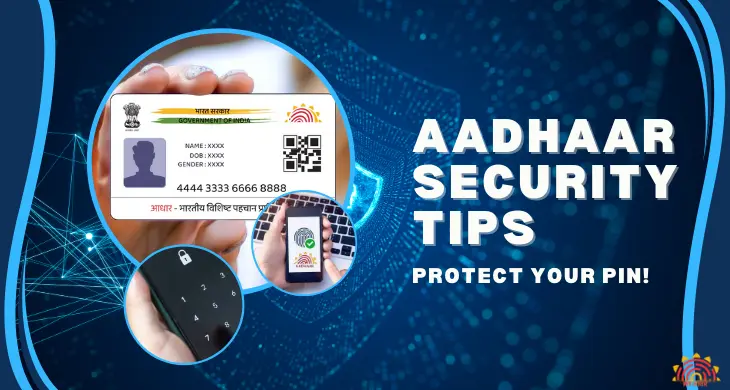Aadhaar, India’s unique identification number issued by the Unique Identification Authority of India (UIDAI), is a critical document that has simplified access to various government and private services. However, the digital format of Aadhaar also calls for robust security measures, particularly when it comes to safeguarding your Aadhaar Personal Identification Number (PIN). In this blog, we’ll explore essential tips to ensure the security of your Aadhaar PIN, protecting your digital identity effectively.
Why Protect Your Aadhaar PIN?
Protecting your Aadhaar PIN is crucial for several reasons. First and foremost, your Aadhaar PIN is a vital element in ensuring the security and confidentiality of your personal information. It acts as a secondary layer of protection, preventing unauthorized access to your Aadhaar details.
Here are some key reasons to protect your Aadhaar PIN:
- Identity Theft Prevention: Your Aadhaar PIN helps safeguard your unique identity. If it falls into the wrong hands, individuals with malicious intent can misuse your Aadhaar information, potentially causing serious harm.
- Financial Security: Your Aadhaar may be linked to various financial services and bank accounts. By securing your PIN, you reduce the risk of unauthorized access to your finances and assets.
- Data Privacy: Protection of personal data and privacy is paramount. Unauthorized access to your Aadhaar information can result in a breach of privacy, leading to potential misuse of your data.
- Government Services: Aadhaar is linked to various government services, including subsidies and benefits. Protecting your PIN ensures you receive these entitlements securely and that they are not misappropriated.
Create a Strong Aadhaar PIN:
Creating a strong and secure Aadhaar PIN is essential to protect your personal information and ensure the safety of your identity. Here are steps to help you create a robust Aadhaar PIN:
- Choose a Unique PIN: Your Aadhaar PIN should be unique and not easily guessable.
- Opt for a Longer PIN: Longer PINs are generally more secure. Aim for a PIN with at least 6-8 digits.
- Avoid Personal Information: Do not use easily accessible personal information such as your name, birthdate, or phone number as your PIN.
- Use a Mix of Characters: Create a PIN that includes a combination of numbers, letters (both uppercase and lowercase), and special characters (e.g., @, #, $). This complexity makes it more challenging for others to guess.
- Randomness is Key: Generate a PIN that appears random and lacks any discernible pattern. Avoid sequential or repetitive numbers or characters.
- Don’t Share Your PIN: Never share your Aadhaar PIN with anyone, regardless of the reason.
Keep Your PIN Confidential:
Keeping your PIN confidential is of utmost importance to protect your personal information and ensure the security of your accounts and identity. Consider these essential guidelines:
- Memorize Your PIN: Avoid writing down your PIN or storing it in easily accessible places. Memorize it to prevent others from discovering it.
- Do Not Share Your PIN: Your PIN is for your use only. Never share it with anyone, including friends, family members, or individuals claiming to be from official organizations.
- Beware of Scams: Be cautious of unsolicited calls, emails, or messages requesting your PIN or personal information. Scammers often impersonate legitimate entities to trick you into revealing your confidential details.
- Use Secure Channels: When communicating with your bank, government agencies, or other organizations that use PINs, ensure you are using secure and official channels.
- Change Your PIN Regularly: To enhance security, consider changing your PIN periodically, especially if you suspect it may have been compromised.
- Enable Two-Factor Authentication (2FA): If available, enable 2FA for your accounts. This adds an extra layer of security, requiring both something you know (your PIN) and something you have (e.g., a mobile device) to access your accounts.
Regularly Update Your PIN:
Regularly updating your PIN is a fundamental step in maintaining the security of your accounts and personal information. Here’s why it’s important and how to go about it:
Importance of Regularly Updating Your PIN:
- Enhanced Security: The primary reason to update your PIN regularly is to enhance security. As time passes, the PIN you’ve been using may become more vulnerable to unauthorized access, especially if it’s been shared or exposed.
- Protection Against Data Breaches: In the event of a data breach or security incident at an organization that has your PIN, changing your PIN immediately can help safeguard your accounts from potential misuse.
- Preventing Unauthorized Access: Regularly updating your PIN makes it less likely for someone who has gained unauthorized knowledge of your old PIN to continue accessing your accounts.
How to Update Your PIN:
- Contact the Relevant Organization: If your PIN is associated with a specific organization, such as a bank, government agency, or online service, contact them to inquire about the process for updating your PIN.
- Use Secure Channels: Always use official and secure channels when changing your PIN. This may involve visiting a bank branch, accessing your account online through the organization’s official website, or using a mobile app.
- Identity Verification: Be prepared to provide identity verification when changing your PIN. This could include verifying personal information, presenting identification documents, or providing answers to security questions.
- Choose a Robust New PIN: When changing your PIN, opt for a strong and distinctive one. Utilize a mix of numbers, letters, and special characters.
- Commit Your New PIN to Memory: After updating your PIN, strive to commit it to memory. Refrain from writing it down or keeping it in easily accessible locations.
Beware of Phishing Attempts:
Phishing is a fraudulent practice where cybercriminals impersonate legitimate entities to trick individuals into revealing sensitive information, such as passwords and personal details. To protect yourself from phishing attempts:
- Email Scrutiny: Carefully examine emails, especially those from unknown senders or with suspicious links and attachments. Be cautious of generic greetings and requests for personal information.
- Verify the Sender: Before clicking on any links or downloading attachments, verify the sender’s email address. Legitimate organizations use official domain names.
- Hover Over Links: Hover your mouse cursor over hyperlinks in emails to preview the actual URL. Ensure it matches the legitimate website.
- Avoid Unsolicited Requests: Be skeptical of unexpected emails requesting personal information, login credentials, or financial details. Always double-check with the organization directly.
- Utilize Robust Passwords: Formulate strong, one-of-a-kind passwords for your accounts, and routinely change them. Employing a trustworthy password manager can be beneficial.
- Implement Two-Factor Authentication (2FA): When available, enable 2FA for your online accounts.
- Fortify Your Wi-Fi Network: Guarantee the security of your Wi-Fi network by employing encryption. Alter default router passwords and activate WPA3 encryption for heightened protection.
- Stay Well-Informed: Remain up-to-date with the most recent phishing methods and scams. Staying informed acts as your primary defense.
Aadhaar Biometric Lock:
The Aadhaar Biometric Lock is a security feature provided by the Unique Identification Authority of India (UIDAI) to enhance the privacy and control of Aadhaar cardholders over their biometric data, which includes fingerprints and iris scans. The feature allows individuals to lock and temporarily unlock their biometrics at their discretion. Here’s how it works:
Locking Biometrics:
- When an Aadhaar holder chooses to lock their biometrics, their biometric data is encrypted and temporarily disabled.
- Once locked, the individual’s fingerprint and iris scans cannot be used for biometric authentication.
Unlocking Biometrics:
- To avail of biometric authentication services, such as Aadhaar-based eKYC, SIM card activation, or biometric attendance, the cardholder can temporarily unlock their biometrics.
- The unlocking process is quick and can be performed for a specific time period or a single-use request.
Benefits:
- Enhanced Privacy: Locking biometrics ensures that no one can misuse an individual’s fingerprints or iris scans without their consent.
- Control: Cardholders can easily unlock their biometrics when needed for authorized transactions.
- Security: This feature helps in preventing unauthorized use of biometric data, reducing the risk of identity theft or fraud.
Secure Your Mobile Number:
Securing your mobile number is crucial to protect your personal information and digital identity. Mobile numbers are often linked to various accounts and services, making them a valuable target for cybercriminals. Here are some steps to secure your mobile number:
- Use Strong PINs and Passwords:
- Set strong and unique PINs or passwords for your mobile device’s lock screen and SIM card.
- Avoid easily guessable PINs, such as your birthdate or “1234.”
- Enable Biometric Authentication:
- If your mobile device supports biometric authentication (fingerprint or facial recognition), enable it for an added layer of security.
- Keep Your Device Secure:
- Use security features like Find My Device (Android) or Find My iPhone (iOS) to remotely locate, lock, or erase your device if it’s lost or stolen.
- Install security updates and patches regularly to protect against known vulnerabilities.
- Beware of Phishing Attempts:
- Be cautious about clicking on links or providing personal information via text messages or phone calls.
- Avoid answering suspicious or unsolicited calls, especially if they request personal information or financial details.
- Activate SIM Card Lock:
- Many mobile carriers offer the option to set a SIM card lock. When enabled, a PIN is required to access the SIM card. This adds an extra layer of security, especially if your device is lost or stolen.
- Use Two-Factor Authentication (2FA):
- Enable 2FA for your mobile carrier account and any apps or accounts linked to your mobile number. This requires a secondary authentication method in addition to your password.
- Regularly Monitor Your Accounts:
- Keep an eye on your mobile carrier account and billing statements to detect any unauthorized changes or activities.
- Protect Personal Information:
- Avoid sharing your mobile number on public platforms and social media, where it can be harvested by malicious actors.
Frequently Asked Questions:
Q1: What is an Aadhaar PIN, and why is it important?
A1: An Aadhaar PIN is a four-digit code used for various Aadhaar-related transactions and services. It’s vital as it helps secure your digital identity and personal information.
Q2: Is it safe to share my Aadhaar number without the PIN?
A2: While sharing your Aadhaar number is often necessary, never share your PIN with anyone. It should be kept confidential to ensure security.
Q3: How can I create a strong Aadhaar PIN?
A3: When creating or changing your Aadhaar PIN, use a strong and unique four-digit combination. Avoid easily guessable options like “1234.”
Q4: What should I do if someone asks for my Aadhaar PIN?
A4: Verify the authenticity of the request. Legitimate authorities may require your Aadhaar but should never ask for your PIN. Be cautious when sharing such information.
Q5: How can I check my Aadhaar activity for unauthorized access?
A5: You can monitor your Aadhaar activity by reviewing your authentication history on the official UIDAI website or through the mAadhaar app.
Conclusion:
Your Aadhaar PIN is the key to accessing and securing your digital identity. By following these security tips, you can safeguard your Aadhaar PIN effectively and minimize the risk of unauthorized access to your Aadhaar information. Protecting your Aadhaar is not just a matter of personal security; it’s also a contribution to the overall digital security of the nation.

